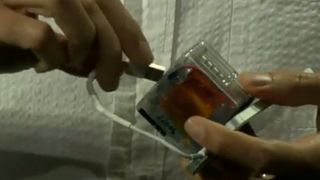Wireless power: could Cota make it long-distance and mainstream?
Is power over Wi-Fi the future of cord-free tech?
"Transmitting at 80KHz ultrasound loses half the energy for every metre it travels, and it doesn't go through walls well, it gets absorbed. It's like when someone has a party down the road and you can hear the bass from their music; you hear the low frequencies but it's the high frequencies you need for charging." He also believes his target $99 price for Cota will be cheaper than ultrasound equivalents.

We've seen a lot of wireless power demonstrations and Cota is still a prototype, but it works – and it reuses enough existing components that manufacturing shouldn't be too pricy. In a couple of years time, you might be able to buy a Wi-Fi access point that not only gets your devices online but powers them as well.
Being able to charge devices without plugging them in has several advantages. The power port takes up a small amount of space, which could be used for a bigger battery or more memory; it's also another hole in the case that makes it harder to create waterproof devices. But if there will always be power available, designers can make different decisions.
A phone could be thinner and lighter with a very small battery that just gets topped up all the time, or a device could be more powerful instead of optimising for battery life. "Devices like remote controls are still dumb," complains Zeine; "the remote doesn't know the state of the TV or what buttons do when you're in different modes. The cleverer learning remotes drain so much power that you have to charge them far more often. The power needs stop remote controls from getting more useful."
Apply that to other things in your home; almost everything from smoke alarms to the clock on the oven to the future Internet of Things sensors could be easier to manage and more useful if you didn't have to worry about the batteries running out.
- Now why not find out which is the best cloud storage: Dropbox vs Google Drive vs iCloud and more
Get daily insight, inspiration and deals in your inbox
Get the hottest deals available in your inbox plus news, reviews, opinion, analysis and more from the TechRadar team.
Mary (Twitter, Google+, website) started her career at Future Publishing, saw the AOL meltdown first hand the first time around when she ran the AOL UK computing channel, and she's been a freelance tech writer for over a decade. She's used every version of Windows and Office released, and every smartphone too, but she's still looking for the perfect tablet. Yes, she really does have USB earrings.
